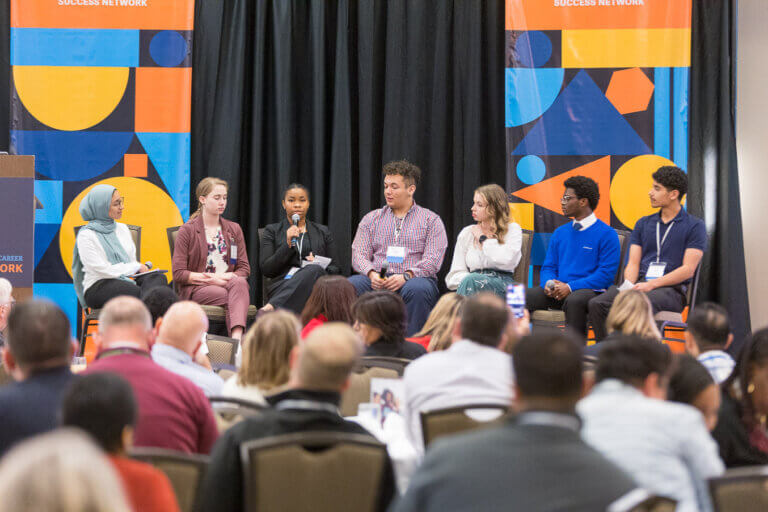Communities around the country have been grappling with the challenges posed by COVID-19 and its implications for learning. While a large part of the public conversation has been around how to translate traditional classroom learning, we also know that it is essential to continue developing valuable employability skills through virtual work-based learning. In this blog post, we will explore issues communities may face and consider as they continue to develop and support quality work-based learning for their youth and young adults.
Grounding Delivery in the Essential Elements of Work-Based Learning
As communities are adapting current work-based learning opportunities or creating new virtual opportunities, they should continue to focus on the essential elements and outcomes of work-based learning to guide their design process. High-quality work-based learning:
- Enhances skills and knowledge in a program of study and/or career interest area
- Develops Essential and Technical Employability Competencies
- Provides authentic, quality engagement with industry experts and opportunities to interact/network
We are continuously uploading examples of virtual activities, resources, and community models for experiences along the work-based learning continuum in the I-WIN Resource Hub.
Within these links, you will hear directly from communities through recorded webinars, view guidance documents broadly applicable as well as specific to industry areas such as the Career Development Experience Toolkit, and learn about platforms that are able to provide robust work-based learning experiences in a virtual setting.
Virtual Work-Based Learning as an Opportunity to Design for Sustainability and Equity
Communities throughout the state have had to shift their approaches to work-based learning abruptly given COVID-19 and associated stay-at-home orders. Organizations are already thinking creatively and intentionally to provide remote opportunities and engagement to ensure that participants1 continue to have access to high-quality, authentic work-based learning opportunities. While current work-based learning efforts should reflect social distancing and health guidelines, communities must also consider how adapting current systems and opportunities can be a strategy to support equity of access.
Virtual work-based learning can address several common barriers for participation, including:
- Transportation: Providing authentic, high-quality work-based learning in a remote environment can increase the number of participants able to access opportunities in a way that doesn’t require transportation.
- Distance, size, and type of partner sites: Through virtual work-based learning, participants can engage with host sites across the state, nation, and even internationally! Virtual work-based learning also provides the opportunity to engage with hosts with small teams, or hosts who don’t have a physical location.
- Diverse student needs for support and access: Virtual work-based learning should be structured to support and address the cognitive, emotional, physical, and sensory needs of participants to engage in high-quality work-based learning. Managing organizations can also be intentional about matching participants to host staff that reflect the diverse identities of participants to better support relationship building and mentoring.
Ensuring Authenticity and Quality
To ensure virtual work-based learning is just as robust and authentic as it is in-person, communities should consider the following factors when designing experiences:
- How are participants intentionally engaged in opportunities for self-reflection and supported to work independently?
- What is the guidance for hosts to communicate safely and provide intentional mentoring to participants? (Resource: Host & Participant Check-In Meetings)
- How are expectations for work products and outcomes being communicated to participants?
- Are virtual platforms being utilized to maintain as much interactivity and targeted engagement as possible? (Use of polls, working in small break-out groups, etc.)
- Do the opportunities provided address multiple levels of technology access and the ability to interact remotely? (Resource: Education Work-Based Learning Continuum)
An Opportunity to Build Entrepreneurship Skills
With the increased focus on self-reflection and independence, virtual work-based learning provides an opportunity to create experiences that can develop entrepreneurial competencies in participants. How can participants help create innovative solutions for the challenges facing communities in the current context? Structuring thoughtful opportunities for such input can help develop entrepreneurship as defined as part of the State’s Essential Employability Competencies. These competencies include:
- Principles of Entrepreneurship: Understanding the process and characteristics of business development and promotion in order to apply strategies of innovation to personal and professional business pursuits.
- Innovation & Invention: Understanding idea generation, design thinking, and product and business development in order to introduce and process new and effective ideas.
- Growth Mindset: Understanding how to learn from challenges, set-backs, and failure in order to adapt strategies and continue efforts to achieve personal goals.
Our current context has required us all to shift abruptly and provide opportunities and learning in ways that we never have before. While it has been a daunting task for many, we hope that the resources, community models, and information provided here will help communities develop and provide meaningful and robust virtual work-based learning experiences that ultimately prepare youth to be college and career ready.


